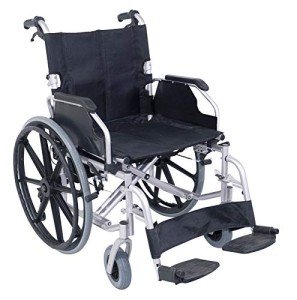What Is Bariatric Wheelchair 24 Inch Seat? History Of Bariatric Wheelchair 24 Inch Seat
Bariatric Wheelchair Seat Width Seat Width Having the appropriate seat width is essential to wheelchair users who invest longer periods in their chairs. Too narrow a seat will cause pressure on the hips and thighs which might lead to sores or pressure points. Having too wide a seat can likewise make it hard for the user to reach the hand rims to move themselves or maneuver in little spaces. To measure the right seat width a person would sit on a chair usually and have their measurement taken throughout their lap at the largest point which is typically their hips. A wheelchair determining tape can be used to measure this, but a backyard stick is chosen as it prevents people from wrapping the tape around their hips which would provide an inaccurate result. The basic wheelchair seat width is 16” (narrow grownup), 18” (standard grownup), and 20” (large grownup). For bariatric clients, a 24” seat is readily available. This durable additional broad bariatric wheelchair from Medline includes swing-away footrests, a carbon steel frame with rust- and chip-resistant chrome plating, and easy-to-clean vinyl upholstery. It has a weight capacity of 500 pounds. Seat Depth Generally, the seat depth of a bariatric wheelchair was added 2” to the measurement taken at the user's largest point (normally their hips). This was implied to accommodate additional layers of clothes that may be used during winter. However, this practice is becoming less common as wheelchair users have the ability to invest more time inside your home and are not using long coats. This makes the seat depth of a chair less essential when picking a bariatric wheelchair. Nevertheless, it is still essential to pick an option that uses adequate support for bigger users. bariatric wheel chair folding extra wide bariatric manual wheelchair features a comfy 24” seat width and a durable slide tube silver vein frame. It also has an adjustable axle and tool-free elevating legrests. Seat Height When it concerns identifying the proper wheelchair seat width you need to always determine from the user's best point which is generally their hips. You will also need to consider whether the user is going to be using a winter coat as this might add 2” to the width required. When a wheelchair remains in usage it need to only be operated on level surface areas with the wheel locks totally engaged. This is to avoid the chair from having the ability to move slopes that are 10 degrees or higher. It is also crucial to bear in mind that any activity that might shift the center of gravity in the chair ought to be finished with care. This consists of reaching for items that require the person to lean out of their seat or trying to stand up from it. Whenever you have the chair in use it is recommended that you frequently examine it for damage and oil any locations that are deemed needed. For example, the casters must be lubed by removing the caster fork and using a multi-purpose grease to use to the caster stem bearings. Similarly, the foot plates can be adjusted by loosening up the bolt and after that moving them to the wanted position. This permits the feet to sit easily on the footplate and avoids any pressure points from forming. This can be very uncomfortable for the user and if left ignored, can result in press sores. Weight Capacity Bariatric wheelchairs are designed to support more weight than standard wheelchairs. This makes them tougher and better equipped to handle falls. They are also normally larger and broader, making them less maneuverable in tight areas than standard wheelchairs. They need lorries with special ramps and lifts to pack them, as well as chauffeurs who understand how to best transport them from one location to the next. When picking a wheelchair, consider its weight capacity as it will be the main determining aspect in whether it will accommodate your passenger's requirements. The weight capacity of the chair is often noted as a static load, indicating that it suggests the quantity of weight the chair can easily hold while standing still. Nevertheless, some producers likewise list an active load that is based on a drop test and can imitate the effect of someone sitting down in the chair. This may be a more reputable measurement of the weight limit, depending upon your requirements.  If you plan to carry out activities that move your center of mass in the seat (such as reaching for things), be sure to have front casters pointed in a forward instructions and wheel locks engaged so the chair will not tip over. Also, inspect that casters are lubricated frequently to prevent extreme wear and abrasions. The lubrication treatment involves getting rid of the fork, separating the caster from the wheel, and greasing the caster stem bearings with top quality multi-purpose grease.
If you plan to carry out activities that move your center of mass in the seat (such as reaching for things), be sure to have front casters pointed in a forward instructions and wheel locks engaged so the chair will not tip over. Also, inspect that casters are lubricated frequently to prevent extreme wear and abrasions. The lubrication treatment involves getting rid of the fork, separating the caster from the wheel, and greasing the caster stem bearings with top quality multi-purpose grease.